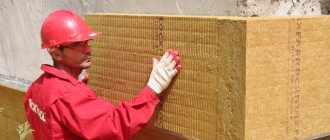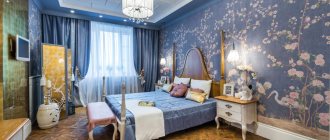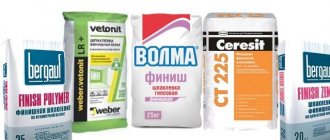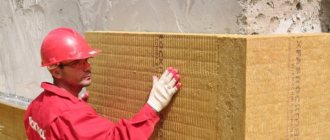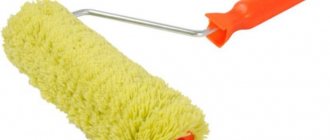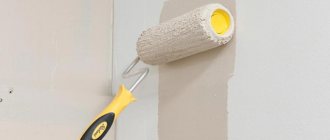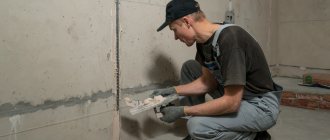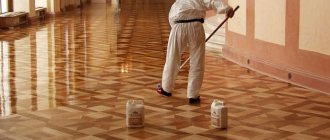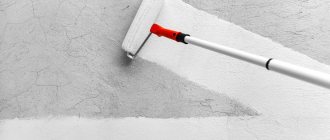Gone are the days when wallpaper was simply glued to the walls of apartments. Now special finishing of the internal walls is being carried out in order to achieve a longer service life of the coating and to make the rooms protected from external sounds and noise. For this purpose, a special wallpaper backing is often used, which is an excellent means for leveling and soundproofing walls from neighbors.
In budget real estate, the walls have poor sound insulation, so it is recommended to use a substrate during renovation, on which the wallpaper will then be glued.
Advantages of substrates
First of all, wall coverings are used to make the room warm and protected from external street noise. Also, wallpaper backings are an excellent material that helps to decorate walls and glue the material evenly. Other advantages of this technology include:
- High degree of strength, so the material will not tear quickly.
- The substrates are made from environmentally friendly materials.
- Prevents the formation of condensation and fungi.
- Creating a comfortable atmosphere in the room.
- Long operating time.
Thus, the range of applications for substrates is varied. The use of the material allows you to solve several problems that are typical for modern apartments and houses.
Types of substrates
The interior decoration of the rooms depends on the type of substrate selected. It is selected based on the following factors:
- The number of residents in an apartment or house.
- Location of housing.
- The influence of temperature, nature and weather conditions.
- Level of humidity and dampness.
There are several types of wallpaper substrates, which are most often used for interior decoration:
- Foamed polyethylene, which has a porous structure, lightness, and low thermal conductivity. This type of substrate is used to create warmth in the apartment. This material allows you to create sound insulation and retains its qualities at temperatures from +60 to +90. You can glue foamed polyethylene to concrete walls, reducing insulation costs. This substrate is sold in rolls.
- Cork backing is made from natural material, therefore it is safe, environmentally friendly, and has an excellent level of sound insulation and adhesion. It is recommended to use for rooms with thin walls, if the “effect” of street noise is constantly present in the house. This will protect your apartment or private house from barking dogs, neighbors’ voices, car horns, and the sounds of repairs from neighboring apartments. Cork is an excellent thermal insulation material, but it is susceptible to moisture and water. Therefore, this type of substrate is not recommended for regions or apartments with a humid climate.
- Non-woven backing is made from modified cellulose, which allows the material to remain resistant to steam. Thanks to this, the normal process of airing and ventilating the walls and removing moisture from living spaces occurs. Non-woven fabric is elastic, which allows it to be used on walls with uneven surfaces.
- Drywall is a hard type of substrate for wallpaper; it is used less often than other materials because it is susceptible to dampness and moisture. When using drywall, you must leave a gap between the wall and the material.
Selection of adhesive composition
Different types of insulation require different adhesives. Expanded polystyrene insulation and polyfoam can be fixed to the wall using adhesives designed for heavy wallpaper.
The most durable adhesives are those based on carboxymethylcellulose (CMC) and methylcellulose with the addition of PVA. Among domestic brands, KMC Super Extra and Moment Classic stand out. Foreign wallpaper adhesives are widely represented on the Russian market.
Special mention goes to Kleo, Semin (France), Pufas and Metylan (Germany).
Cork insulation cannot be glued with regular wallpaper glue. Special adhesives are used for it. Adhesives received positive reviews: Pufas K12, Lacrusil, Multifix, Wakol.
Acoustic wallpaper
On the finishing materials market you can also find a special type of wallpaper - acoustic. They are sold in rolls or slabs, so they are convenient to use for gluing ceilings and walls. Acoustic wallpaper has a high level of sound absorption. Surfaces perfectly reflect sound, resulting in a reverberation effect - sound creates an echo. To achieve this effect, the structure of acoustic materials is made from the following materials:
- Cellulose, i.e. paper. Sometimes it is replaced with non-woven fabric. These materials act as the basis of the wallpaper.
- The outer layer (top) is covered with acrylic fabric or other fibrous materials consisting of fibers. Thanks to this, the fibers absorb sound.
There are acoustic wallpapers made from cork and finishing materials made from wood. In particular, from veneer, from bamboo, from grass. The thickness of the wallpaper is 3-4 mm, which depends on the material.
Soundproof acoustic wallpaper can be used to decorate the following rooms:
- Houses with low levels of sound insulation.
- Cinemas.
- Canteens.
- Bedrooms.
- Meeting rooms.
- Cabinets.
Advantages and disadvantages
Acoustic wallpaper is used for wallpaper substrates, which allows you to create a high-quality level of noise protection in apartments and houses. Other advantages of the material include:
- The backing is very easy and simple to work with, which allows you to cut it into pieces without much effort, as well as gluing it to the walls.
- When gluing, workers will not suffer from dust and odor.
- Environmental friendliness of the material.
- Long service life.
- Moisture resistance.
- Excellent fire characteristics.
- Impact resistance.
Effect after insulation
People planning to renovate their apartment doubt that insulation under wallpaper really “works.” First of all, the question is about its thermal insulation abilities. To prove the performance of roll materials, the following examples can be given:
- Polyfom has a thermal conductivity coefficient of 0.03 W/mK, which can be equated to brickwork more than 10 cm thick or a wooden covering 5 cm thick.
- Foil insulation 5-6 mm thick provides thermal insulation similar to a half-brick brick wall.
- Numerous experiments show that cork insulation 8-10 mm thick raises the temperature inside an unheated room by 3-4 degrees.
These examples perfectly show that the insulation under the wallpaper copes with its task. In addition, it must be taken into account that the cork creates a thermos effect. It helps keep the house cool in hot weather. To obtain complete comfort in the house, you should ensure a combination of wallpaper insulation with external wall insulation.
Prices for soundproofing materials and acoustic wallpaper
- The noise-absorbing material, which is created from foam rubber panels, helps to create an excellent acoustic effect in the apartment, its price is 1,535 rubles / package.
- European volumetric wallpaper stickers with a 3D effect - the cost varies from 230 to 29.5 thousand per piece.
- Self-adhesive wallpaper, which is made of foam - the price is 361 rubles / piece.
- Acoustic panel that allows you to create excellent sound insulation - from 111 rubles / piece.
- Acoustic panels made of leather with 3D effect - 21.1 thousand rubles/lot.
- Polyester acoustic wallpaper - from 1.4 thousand to 1,772 rubles / lot.
- Foam acoustic panel - from RUB 1,650.
- Decorative acoustic panels made of leather - from 22.1 thousand/lot.
- Self-adhesive 3D wallpaper “brick-like” - from 525 to 880 rubles/piece.
- PVC for gluing walls - from 153, 562 rubles / lot.
Soundproofing materials that are used to create comfort in an apartment differ in cost and the material from which they are made.
Before purchasing, you need to check with specialists for which room such wallpaper is suitable and whether it can be used as a backing.
Pasting process
The backing is very easy to use, so you won’t have to work hard with it while working. You only need to do the following:
- Completely clear the wall of wallpaper or other material.
- Large cracks and crevices are smoothed out by covering with plaster.
- The wall must be leveled so that there are no large differences due to unevenness. If such a need arises, the wall should be re-primed.
- The wall must be clean and dry.
- The roll of backing is cut into sheets of the length required for gluing. It is worth remembering that for non-woven wallpaper, you buy a special glue for non-woven wallpaper, which is applied only to the wall. For polyethylene foam and cork, glue must be applied to the substrate and the wall. After spreading the glue, wait 3 to 5 minutes for it to dry slightly. This will make it easier to place sheets of material in the desired place on the wall.
- The backing strips must be glued joint to joint, and then the seams must be reinforced with paper tape.
The substrate dries within 72 hours, after which you can begin gluing the wallpaper. This should not be done before, otherwise they will not stick well and “wrinkle”.
It is better to wait a few days until the wallpaper backing is completely dry. To ensure that the wallpapering of the room does not suffer from the poor quality of the work performed, it is not recommended to carry out work at high temperatures. The ideal temperature is +10, so repairs should be done either in spring or autumn. There should be no drafts in the room where they plan to work with the wallpaper backing.
When buying wallpaper, people mainly rely on their beauty, and not everyone thinks about whether they will be combined with the surface on which they are supposed to be glued. Almost all types of this design element can begin to show through over time, and in order to prevent this from happening, a backing or base for the wallpaper must be applied before gluing.
Properties of wallpaper bases
In addition to its main function, the base can also perform others, allowing you to increase the comfort in the room and its aesthetics.
- The base smoothes out uneven walls, facilitating further wallpapering.
- Due to the layer between the walls and wallpaper, thermal insulation increases.
- Some types of substrates additionally increase the sound insulation of walls.
- Due to the fact that the entire surface of the base has the same absorbent characteristics, the adhesive is distributed more evenly when applied. The same property ensures uniform drying of the glue over the entire surface and better adhesion.
- When applying wallpaper to a treated surface, it is easier to align their joints.
Paper base
If you paste wallpaper on plaster, small irregularities may appear through them, which remain after applying this material to the wall. The simplest paper base will help eliminate them. It is also called lining wallpaper. This type of substrate perfectly levels out all minor surface imperfections.
A paper backing is also used if there is already wallpaper on the walls, but it is quite difficult to remove it. This material helps save time during repairs, since the thick paper that makes up the base reliably covers the pattern of the old wallpaper. And the stains on the “bare” walls after gluing it will become less noticeable.
Non-woven base
Non-woven fabric has been on the market for a long time; wallpaper made from this material is the most popular. There are also substrates based on this material. They have the same properties as paper ones, but their strength is an order of magnitude higher.
It's all about the material itself. It is made from special, modified cellulose. It helps to increase not only strength, but also allows the walls to “breathe,” thereby increasing the drying speed of the glue and reducing the possibility of the wallpaper “sliding.”
Popular brands
Among the most common manufacturers on the Russian market, as well as other CIS countries, the following brands can be mentioned:
- Polyf (also known as Poliform).
- Ecoheat, from the manufacturer Isolon
- Penolon.
- Globex (Globex).
- Penohome.
Many buyers, considering popular brands, wonder which is better? In fact, it is difficult to draw clear conclusions and choose just one of them, since the products of all major manufacturers are of a high level of quality. As for the form of release, most of them (polyethylene foam, cork, and so on) are produced in rolls, thus reminiscent of more traditional and familiar wallpaper to all of us.
Ecohit is one of the market leaders
Cork backing
Cork is rapidly gaining popularity in construction. It is used both as decorative elements and in the form of substrates - both for floors and walls.
Cork has become so widely used due to its superior thermal insulation properties compared to other materials. In addition, due to its structure, this material absorbs noise well. Therefore, it is widely used in residential areas with thin walls, through which cold and extraneous sounds can break through.
To make a backing for wallpaper, a special technical cork is used. To glue it together, special types of glue are used, which increase the strength of the material.
But cork has one property that is not very good for wallpapering. It has very weak adhesion, so before applying wallpaper to the surface, it should be thoroughly primed.
Flaws
Among the shortcomings, formed according to consumer reviews, are:
- insufficient number of repaints;
- impossibility of applying putty.
However, both disadvantages are quite controversial. Seven repaintings of high-quality non-woven fabric already guarantee a 35-year service life, taking into account repainting every five years.
Regarding the application of putty, it is worth noting that the material was created to eliminate the need for subsequent putty, as is the case with fiberglass web. If the surface is not ideal enough, then it is rational to apply a putty layer under the lining.
Drywall, OSB and plywood
If the walls have strong unevenness, then in order to hide them, it is necessary to use more serious types of substrates. They can be sheet materials with a width of 4 mm or more:
These types of materials will easily hide the imperfections of the walls, but to apply them you will need to build a frame on which they will rest. To construct it, you will need rectangular beams (logs) with a cross-section of 2x4 cm. If the surface has strong convexities, then their dimensions can reach up to 5x5 cm.
The beams are attached to the wall in the form of a lattice using screws and dowels. First, vertical logs are laid; they should be positioned so that when installed, the panel covers half of its width. Next, horizontal bars are applied; they must be placed between the vertical ones. The distance between horizontal joists can vary from 0.3 to 1 m, depending on how wide the bulges in the wall are.
Instead of wooden beams, you can use a U-shaped aluminum profile.
Next, sheets of material are placed on the logs. They are fastened using 16–19 mm self-tapping screws. The distance between the screws should be approximately half a meter, but no more, since if the fasteners are set too widely, the substrate may begin to “walk.”
After the panels are securely fixed to the wall, it is necessary to work out the joints so that they do not show through under the wallpaper. This can be done using putty.
Putty can create additional unevenness, which is why the joints can stand out, especially on light-colored wallpaper without or with a weak pattern. Therefore, it is recommended to combine the panel backing with other types, for example, paper.
You can also increase sound and heat insulation by filling the cavities between the wall and the substrate. This can be done using polyurethane foam. To do this, you need to make two holes in the panels in the space between the joists with a 6 mm drill. They should be located at the top corners of the empty space. Next, you need to pump foam into one of them. This must be done until the foam flows through another hole.
After sealing, you need to wait a day and then close the holes with putty. This solution will preserve heat and prevent extraneous sounds from entering the room.
Cost of insulation
The price range of these products may vary depending on the chosen manufacturer, as well as the material itself. Below is the average cost per item:
- Roll insulation for wallpaper, price varies from 800 to 1000 rubles. total area 5 sq.m.
- Cork insulation. Depending on the thickness, the cost of the product varies from 800 to 6000 rubles.
- Polyph. 1100 rub., per package. Total area 7 sq.m.
The most widespread among all the presented materials was the polyphome. It is easier to glue it to the wall, and if you follow all the manufacturer’s recommendations, it perfectly insulates the walls of the room.
Soundproofing underlay
In order to reduce the level of noise coming from outside, soundproofing substrates are used in the premises. They are made from foamed polyethylene. This material is located between two layers of durable paper.
This type of insulation is used as a substrate where it is impossible to install soundproofing structures. In addition, it has thermal insulation properties that are quite suitable for interior walls of buildings. Also, this type of base hides wall defects well due to its thickness.
Paper
The paper backing for the wallpaper is made from wood, so it is absolutely safe for people. It is indispensable in cases where it is impossible to remove old finishes from the walls. It has low strength characteristics and does not allow you to hide wall defects.
It comes in two types:
- For heavy wallpaper. The paper backing for this type of wallpaper has a dense and thick base, so it can support the weight of the main wall covering.
- Thin. They are not tight, so walls can often be seen through them.
You can find reviews on all types of wallpaper substrates on the Internet, on store websites and thematic sites, which will allow you to choose the right material for your walls.
Thermal insulation base
2 types of materials can be used as a basis to prevent the entry of cold:
Putty may contain sawdust or polystyrene; sometimes there are types with mineral fillers. But it takes longer to install as it needs to be applied first and then treated to make the wall smoother.
It is much easier to use a rolled insulation backing. It consists of two layers:
This type of base is quite easy to attach to the wall, as it is self-adhesive. This means that even a child can work with it. Due to the presence of polyethylene foam, this substrate can also perform a soundproofing function and can also smooth out uneven walls.
Substrate for liquid wallpaper
The use of standard substrates is not suitable for liquid wallpaper or paint. Even if the walls are uneven and you had to use panels to level them, you still need to apply a special base on top of them. It is necessary in order to reduce the absorption of walls and smooth out color defects.
As a base, it is necessary to putty the wall, after which it is necessary to apply 2 layers of primer.
In order for the wall to have a uniform color over the entire surface, it is recommended to apply white paint to it before painting it in the desired color.
If the wall is made of crumbling concrete, then a special strengthening primer is used for the base, which will prevent further crumbling of the wall during painting.
For each room, it is necessary to choose the most optimal type of wallpaper base so that it combines as many positive qualities as possible. After all, increased thermal insulation is not always required. And external sounds are often practically inaudible in brick houses.
But the use of a backing is still necessary, since it will not be possible to paste wallpaper onto plaster without it. In addition, without it, over time, all the flaws and stains that were on the concrete will appear on the wallpaper.
Insulating backing for wallpaper and its most important properties
A high-quality non-woven backing, laid between the wall and the wallpaper, becomes an insurmountable barrier to moisture, thereby preventing the development of mold. In addition, such material can dampen vibrations and increase the sound insulation of the room.
The insulating backing under the wallpaper also, to a certain extent, prevents heat loss in the room and does not allow cold air from outside to penetrate into the rooms. The degree of insulation depends on the thickness of the material, as well as its quality.
Modern soundproofing wallpaper backing, produced by different manufacturers, may differ in its physical qualities, thickness, length and width of the roll. A high-quality substrate should withstand even heavy wallpaper.
Is it possible to glue wallpaper over foam plastic?
The most popular insulation material was and remains polystyrene foam - ordinary polystyrene foam. Due to its minimal cost and good thermal insulation characteristics, this material is used everywhere - for insulating walls, facades, ceilings, floors, etc.
Of course, the rationality of using this insulation is difficult to dispute, but it is worth understanding that polystyrene foam is not the best choice for direct wallpapering.
Firstly, the surface of the foam does not have sufficient rigidity, as a result of which, even with minimal external influence (someone leaned against the wall, or the wall was caught by some object), the wallpaper will break through.
Secondly, since polystyrene foam, like Izover Optimal insulation, is a slab material, and for effective insulation from the inside of the walls you will need at least a 5-centimeter layer of insulation, the joints of the foam plastic after pasting will be very noticeable under the wallpaper.
Thirdly, when the time comes to redecorate the room, and you need to change the wallpaper, you will have to change the insulation along with it, since you will not be able to tear the wallpaper off the surface of the foam without damaging the latter.
Related article: Why walls in a private house become damp
And the last factor that prevents you from gluing wallpaper onto polystyrene foam is the issue of fire safety, since according to SNiPs, polystyrene foam must be insulated with a layer of non-flammable material.
If you want to insulate the walls from the inside of the house with polystyrene foam, then for subsequent wallpapering you can either cover the thermal insulation with plasterboard, or cover the insulation with a reinforcing plaster composition using fiberglass plaster mesh. But for such a thing, sometimes it’s easier to buy polyurethane-based insulation in Kirov.
Plastering foam plastic using reinforcing mesh
Soundproofing backing for wallpaper: how to choose
Nowadays, people purchasing wallpaper for renovation are increasingly deciding to use a backing, which is easiest to purchase using specialized Internet resources. To do this, enter the query “buy wallpaper backing” in the search bar and select a high-quality material from the offered options.
Good backing for wallpaper:
– must demonstrate high moisture, steam, sound and heat insulation properties;
– be environmentally friendly and safe for people, pets, and the environment;
– show resistance to bacterial and fungal infections;
– provide a perfectly flat surface for wallpapering;
– allow for repeated gluing of wallpaper;
– easy to stick, sticks firmly to the walls;
– do not require finishing plastering of the surfaces to be coated.
A soundproofing underlay for wallpaper that meets the characteristics listed above will improve the microclimate in the room being furnished and make the home more comfortable and convenient.
Does it save you from mold?
The answer to this question can be confidently given in the affirmative. Resistance to mold and fungal attack is inherent in the very nature of these materials. Cork tends to absorb moisture, but even this circumstance does not lead to these negative phenomena. Polymer insulation is good waterproofing; they do not accumulate moisture, which prevents the formation of a favorable environment for mold.
Roll insulation is rightly considered a practical and effective substrate for wallpaper. They smooth out small surface defects, provide hydro-, steam-, and thermal insulation of the room, and protect walls from mold and fungi. The costs are offset by comfort in the home and an increase in the service life of the finishing coating. If the insulation is installed correctly, it will perform its functions for a long time and reliably.
How to glue the backing under the wallpaper?
We don’t have to talk long about how to glue the backing under the wallpaper - this operation is quite simple and does not require specialized construction skills.
Old wallpaper, paint, layers of lime, and other loose materials are removed from the walls being tiled. Identified gaps, cracks and chips must be covered. Then, the walls are primed. The backing cut to size is glued end-to-end using heavy wallpaper glue. Construction tape must be applied over the seams. Wallpapering walls is allowed only after the substrate has completely dried; the drying time is indicated on the packaging of the material. It is allowed to place photo wallpaper on the wall, vinyl and paper sheets, and other types of wallpaper on top of the insulating sheets.
Today on sale are sheets of polyethylene foam, cork backing for wallpaper, and other options for insulating materials.
How to glue insulation to walls with your own hands
When thinking about how to insulate a wall inside an apartment under wallpaper, you need to know that the technological sequence of operations for thermal insulation of walls under the finishing coating is similar to the process of gluing wallpaper and includes the following steps:
- Processing the base for gluing thermal protection.
- Preparing insulation and glue for further work.
- Sticker of heat-protective material for future finishing.
Let us dwell in detail on the specifics of each stage of work. At the preparatory stage, perform the following activities:
- Clean the surface of any existing wallpaper.
- Remove loose pieces of plaster and remaining trim.
- Remove protruding nails, protruding reinforcement and fasteners.
- Use a chisel to knock out concrete and cement sagging.
- Clean the surface from dust and dirt.
- Seal the cracks and cavities with cement mortar.
- Coat the prepared surface with a deep penetrating primer.
- Reapply primer to improve adhesion.
PVA glue
Experts sometimes use PVA glue for priming and antiseptic treatment, which, like primer, is applied with a paint brush or wide roller. After the soil has completely dried, further measures can be carried out. The drying time is regulated by the manufacturer of the primer composition and is indicated on its packaging.
Follow the following algorithm to prepare the substrate and adhesive mixture:
- Calculate the required number and sizes of substrate fragments.
- Use a tape measure to measure the dimensions of the future thermal protection sheets.
- Cut the insulation into pieces of the required sizes.
- Carefully study the manufacturer's instructions for preparing the adhesive composition.
- Dilute with water and vigorously mix the glue ingredients.
Please note that the amount of roll substrate required to complete the work must be calculated as follows:
- Determine the total area of the walls to be thermally insulated.
- Divide the resulting value by the area of one roll of backing.
- Multiply the estimated number of rolls by a safety factor of 1.05–1.1.
- Round up the resulting value.
The final stage of work is the installation of insulation, which must be carried out under the following conditions:
- ambient temperature and the surface being treated is more than plus 10 °C;
- maximum moisture concentration in the room up to 70%;
- complete absence of drafts.
Wallpapering
Further procedure:
- Mark the vertical and mark the base.
- Apply the adhesive evenly to the wall surface.
- Lubricate the back of the insulating sheet with glue.
- Let the material soak for 5 minutes.
- Attach the insulation to the base, following the markings.
- Remove air bubbles by smoothing the surface of the glued sheets.
To smooth out and remove air bubbles you can use:
- wide spatula;
- regular roller.
When performing work, pay attention to the following nuances:
- uniform lubrication of the surface with glue;
- no gaps when installing panels;
- sticker of the backing from the ceiling to the floor;
- rolling with a roller from the center to the outer parts;
- the need to glue the joint areas using masking tape.
Ventilation of the room can be carried out no earlier than 24–72 hours after completion of thermal insulation measures, depending on the properties of the heat-insulating material.
